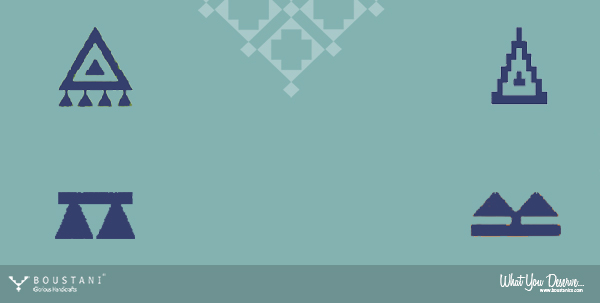Motifs are derived from symbols that were used in ages gone by to inform, communicate and to convey ideas. Over time, some of these signs merged with myths, acquired hidden significance and moved into the world of esoteric symbolism. In this context, their use may not be limited to decorative purposes. Due to the hidden forces they are believed to imply, their primary purpose may well be psychological rather than aesthetic.
Here is a comprehensive list of commonly used motifs in Persian rugs...
Amulet, Evil Eye
It is believed that some people possess a power in their glance which causes harm, injury, misfortune and even death. Evil eyes are various objects that reduce the effect of evil glance, thus protecting the ones who carry them. Blue beads, wild mustard, garlic, sea shells, old coins, lead, mercury, the shell of a small turtle, silver and gold Mashallah motifs (inscription of the word meaning God save him on gold or silver) are used with this purpose.
Muska is a written charm which is believed to have a magical and religious power to protect the possessor from dangerous external factors. It is generally carried in triangular cases. Various form of amulet and evil eye motifs including the Solomon's Seal which is called a star amulet in Persian carpets are illustrated below:

Hand, Finger, Comb
The number of fingers on the hand, which is five, is used as a protection against evil eye.
In Persian culture the concepts of fertility and motherhood which implies birth are closely related. This relation can be traced back to and Virgin Mary. During the Islamic period it was symbolized by the name of "Mother Fatima" or "Mother Fadime". The motif called Hand of Mother Fatima is widely used in Persian weaves.
Hand motif is used against spell and evil eye. Comb motif is largely related with marriage and birth. It is used to express the desire for getting married and to protect birth and marriage against evil eye.
Persian variations of this group of motifs are illustrated below:

Eye
The source of an evil glance is the human eye. It is believed that the harms it may cause can best be prevented again by a human eye.
A diamond divided into four is quite a common representation of the eye as used on weaves. A triangle is a stylized form of the eye. Some eye motifs are formed of squares and rectangles. The eye motif used on weaves differ from one region to another.
Here are various forms of the Eye motif:

Hook
Another Persian motif used against evil eye is the hook. It is also called Ghollab.
Various applications of this motif are presented in the illustrations below:

